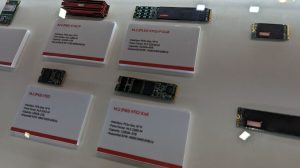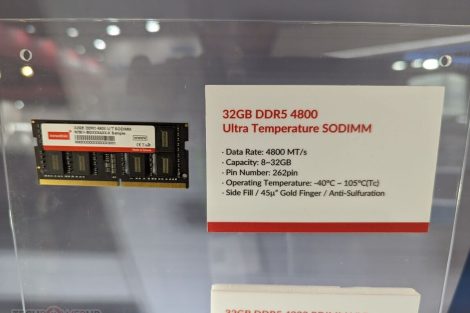Innodisk has proposed an innovative solution to implement PCIe Gen 5 NVMe SSDs. Instead of keeping the M.2 form factor, they propose to design them as PCIe add-in cards. This would eliminate the need for oversized cooling with noisy 20mm fans, and SSD designers could instead use cooling solutions similar to those used on graphics cards. Gen 5 NVMe controllers have a power consumption of about 15 W, which is about the same as a motherboard chipset. The M.2-2280 form factor is too small to use a large enough heat sink. Therefore, SSD designers are forced to resort to active cooling with 20 mm fans, which do not sound very pleasant. In comparison, most cooling solutions for single-slot graphics cards get by with 15 W of waste heat and are much quieter, some even without fans.

The Innodisk 5TG-P AIC SSD features a PCIe Gen 5 + NVMe 2.0 SSD controller accompanied by a large passive heat sink. The drive features a PCI-Express 5.0 x4 host interface and offers an impressive 32TB capacity. It is fully slot-powered and uses 3D TLC NAND flash and a generous DDR4 DRAM cache. According to the company, the SSD achieves sequential transfer rates of up to 13 GB/s in both directions. Innodisk designed the PCIe 5TG-P specifically for workstation and HEDT applications and offers it in server-relevant form factors such as U.2 and E.1S. A CrystalDiskMark screenshot shows a sequential read speed of 13.62 GB/s and a sequential write speed of 11.55 GB/s.
The nanoSSD PCIe 4TE3 is a single-chip BGA SSD with a PCI-Express 4.0 x4 host interface. It is available in various capacities from 128 GB to 1 TB and offers impressive sequential transfer rates of up to 3.6 GB/s read and up to 3.2 GB/s write. The P80 4TG2-P is an M.2-2280 SSD designed for use in the client segment and features a PCI-Express 4.0 x4 interface. It has been specifically tested for compatibility with the PlayStation 5 and is available in capacities ranging from 512GB to 4TB. With sequential transfer rates of up to 7.1 GB/s read and up to 5.8 GB/s write, this SSD offers impressive performance.

The P42 4TE2 is an M.2-2242 SSD designed specifically for the OEM and SI markets. It is equipped with a DRAMless Gen 4 controller and is available in a range of capacities from 128GB to 2TB. With impressive read speeds of up to 4 GB/s and write speeds of up to 3.4 GB/s, this drive offers fast data transfer. The P110 4TG2-P iCell, on the other hand, is an M.2-22110 SSD with a Gen 4 interface. Its longer design allows room for a capacitor bank that protects the drive from power failures. The drive is available in capacities ranging from 512GB to 4TB and impresses with sequential read speeds of up to 7.5GB/s and write speeds of up to 5.3GB/s. For those who prefer the popular M.2 2280 form factor, there’s the P80 4TE2 iCell. Although it is a scaled-down version of the P110 model, it uses a compact DRAM-free architecture to free up board space for the capacitor bank. Still, it offers solid performance and is available in a variety of capacities.
Innodisk also showcased a wide range of DDR5 DRAM products in various form factors such as standard UDIMM, R-DIMM and SO-DIMM. These products are suitable for a wide range of applications, from PCs to servers. Of particular note are the ultra-temperature-class DDR4 and DDR5 SO-DIMMs, which are specifically designed for use in outdoor, embedded, industrial and automotive applications. These SO-DIMMs offer an extreme operating temperature range of -40°C to 125°C and are available in memory capacities from 8 GB (single-rank) to 32 GB (dual-rank).
Source: TechPowerUp






































4 Antworten
Kommentar
Lade neue Kommentare
Mitglied
Mitglied
Urgestein
Urgestein
Alle Kommentare lesen unter igor´sLAB Community →